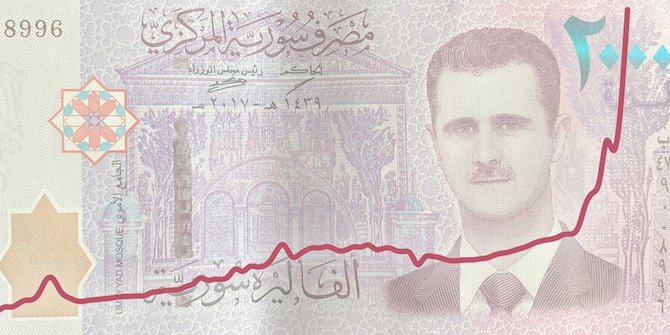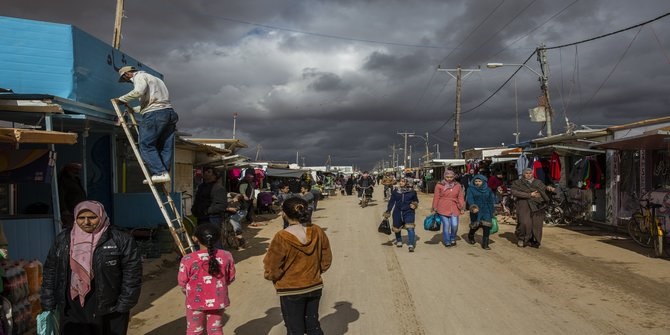by Hussein Chokr

The depreciation of the Syrian currency is on the front pages again. In 2019, around 40% of Syrians were living under $1.90 a day, 11.7 million were in need of at least one form of humanitarian assistance, 6.5 million suffered from food insecurity, and 13.2 million required healthcare. Various factors are at the root of these dire socioeconomic realities, yet one of the most significant ones is the depreciation of the Syrian lira, which has led to hyperinflation and impacted people’s ability to afford basic needs.
During the first 5 years of the war, the Syrian lira dramatically declined in value against the US dollar, mainly due to domestic, conflict-related factors, including a loss of oil export revenue, international sanctions on the Syrian banking system, trade deficits, and inadequate central government intervention, just to name a few. However, over the past two years in particular, the drastic drop of the Syrian lira’s value is mainly due to external factors such as the ongoing economic crisis in Lebanon, and the enforcement of the Caesar Act.
To understand the significant role of such external factors on the steep depreciation of the Syrian lira, this piece outlines two noteworthy rounds in its value drop. The first one, between 2011 and 2016, saw the lira lose 714% of its value, with an average drop of up to 30 liras per month. Afterwards, the currency regained stability for almost three years, before a second drop that began in the third quarter of 2019. Considering the ongoing consequences of the Lebanese economic crisis and the Caesar Act, it only took the lira two years to lose around 750% of its value during this second round, which is more than what it lost in the 7 years prior to that.
Domestic Factors Affecting the Syrian Lira’s Decline
Before the crisis, foreign currency reserves in Syria were highly dependent on oil revenues. However, due to the war, the country lost control over its oil fields and transiting pipes, which by default, undermined its ability to acquire petrodollar revenue. Also, the restrictive measures imposed on the Syrian banking sector have isolated the country’s financial market from the international financial system. This exclusion jeopardised Syria’s ability to gain access to foreign currency markets. Moreover, Syrian exports decreased and imports increased, rendering the negative trade balance $5.32 billion in 2019. The need for foreign currency to finance the import of basic goods has put pressure on the demand for US dollars and contributed to the Syrian lira’s steep fall.
The policies of the Central Bank of Syria have failed to address the Syrian lira’s value drop. Indeed, the bank closed several transfer offices and authorised specific international transfer offices to hand transactions on preferential Syrian lira/US dollar rates. The Syrian presidency also prohibited the use of currencies other than the Syrian lira. Nonetheless, these steps did not resolve the issue, and merely contributed to a temporary sense of stability.
Throughout the first phase of the currency’s decline, the internal economic consequences of the war played a major role in destabilising the Syrian lira. While the impact of these internal factors persisted, the Syrian market to some extent succeeded at adapting and stabilising the Syrian lira between 2016 and 2019. This did not however prevent the currency from experiencing a second steep depreciation in the third quarter of 2019 which, as mentioned above, was driven by international factors. To adequately analyse the situation, it is therefore important to consider the micro changes in the currency’s rate fluctuation in alongside ongoing geopolitical events.
The Lebanese Financial Crisis and the Caesar Act
In late 2019, the value of the Syrian lira started to fall again. This time, it was not due to the war, but more so due to the Lebanese financial crisis. Indeed, the Lebanese banking sector was home to more than $40 billion from Syrian depositors. The sector was almost the only supplier of foreign currency to the Syrian market. According to a study from Syrian Professor Ali Kanaan, due to the difficulty in US dollars reaching Syria through Lebanese banks, an estimate of $4 million per day of transactions are lost. As a result, the Syrian market started to rely on the Lebanese lira to purchase and secure a minimal amount of US dollars to offset restrictions imposed on Syrian deposit withdrawals from Lebanese banks.
Lebanon’s political instability and massive debt increased the demand for US dollars in Beirut. The pressure peaked after the mobilisation of 17 October 2019, when Lebanese banks stopped allowing customers (a sizeable portion of whom were Syrians) to withdraw or buy US dollars. This decreased the overall supply and increased the demand for US dollars, which prompted a massive disruption to the thirty year-old fixed exchange rate, whereby the Lebanese lira was pegged to the US dollar at 1515 to 1.
Due to this fall, the Syrian lira has been losing its value against the US dollar on an average of 100 liras per month. It reached 1,305 in April 2020 before it lost 555 liras of its value between April and May, 640 liras from May onwards, jumping to 2,500 Syrian liras per US dollar in June. Although the Lebanese exchange rate in the black market suffered over May and June 2020, there was another reason behind the currency’s drastic depreciation. In June 2020, the Caesar Act was implemented, which further strained the Syrian economy and drained the supply of foreign currency to Syria.
The Syrian lira declined in value again in November 2020 and has not stopped to this day. This sharp fall from 2,630 liras to 1 dollar in November to 4,100 to 1 in the first week of March 2021, confirms again the strong impact of external or international factors on the currency collapse, as well as the strong relation and similar trajectories between the Lebanese and the Syrian liras. Indeed, during the same period, in March 2021, the Lebanese lira jumped from 7,850 to 12,350 per US dollar.







6 Comments